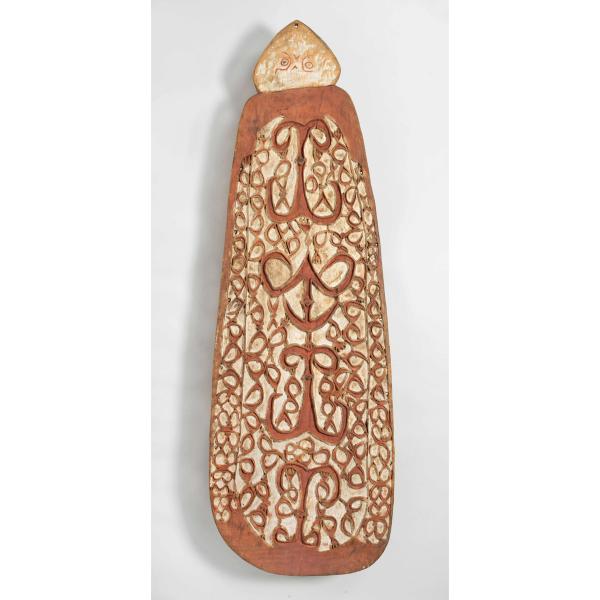Shield
Artwork Details
- Title: Shield
- Artist: Jor
- Date: mid-20th century
- Geography: Indonesia, West Papua, Weo (Wejo) village, Pomatsj River (northern tributary)
- Culture: Asmat people
- Medium: Wood, paint
- Dimensions: H. 74 1/8 in. × W. 25 in. × D. 3 1/8 in. (188.3 × 63.5 × 7.9 cm)
- Classification: Wood-Implements
- Credit Line: The Michael C. Rockefeller Memorial Collection; Gift of Nelson A. Rockefeller and Mrs. Mary C. Rockefeller, 1965
- Object Number: 1978.412.908
- Curatorial Department: The Michael C. Rockefeller Wing
Audio

1750. Shields, Asmat artists
Maia Nuku
KATERINA TEAIWA (NARRATOR): Shields like these protected Asmat warriors—both literally and symbolically. Their carved and painted decorations contain many references to headhunting.
MAIA NUKU: I am Maia Nuku and I am the curator for Oceania here at the Metropolitan Museum of Art.
Headhunting is an important focus for male prestige for many cultures in Oceania. The head itself is really deemed to be the seat of spiritual power.
Acquiring the life force of another was really believed to strengthen one’s own vitality, and preserving the head, which is the center of one’s personal power, had particular resonance.
KATERINA TEAIWA: Headhunting as a practice has commonly been misinterpreted as barbaric or ‘uncivilized.’
MAIA NUKU: It may seem counterintuitive, but the taking of a life was really seen as generative. It was a powerful catalyst that brought about a future phase or cycle of life. So you see this idea that life and death are inextricably linked. Without death, there is no life. And this is tied up with the fertility of the crops like sago.
KATERINA TEAIWA: Sago is a staple food. It’s harvested from a type of palm tree.
MAIA NUKU: There is this deep connection between men and trees in Asmat culture. Humans are equated metaphorically and metaphysically with trees. So, the trunk is really understood to be a torso, the roots are the legs, the branches are its arms, and then the fruit of the tree is really the head or the skull.
KATERINA TEAIWA: For that reason, some of the carvings on these shields also depict birds and animals that eat the fruit, or heads, of trees… like black king cockatoos, hornbills, and flying foxes.
MAIA NUKU: Everyone and everything is connected in Asmat cosmologies and ways of being. And art is the medium that connects the living not only with their deceased relatives and ancestors, but also with the birds and the animals that share the land with the Asmat.
More Artwork
Research Resources
The Met provides unparalleled resources for research and welcomes an international community of students and scholars. The Met's Open Access API is where creators and researchers can connect to the The Met collection. Open Access data and public domain images are available for unrestricted commercial and noncommercial use without permission or fee.
To request images under copyright and other restrictions, please use this Image Request form.
Feedback
We continue to research and examine historical and cultural context for objects in The Met collection. If you have comments or questions about this object record, please contact us using the form below. The Museum looks forward to receiving your comments.
